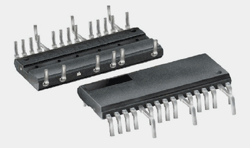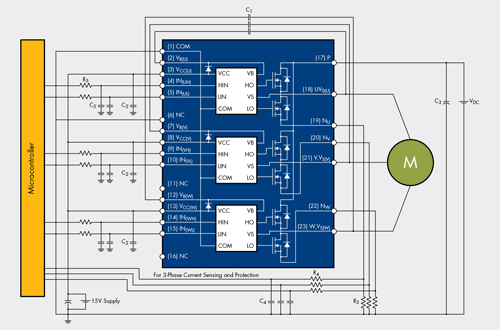Smart power switches help reduce losses up to 25% and allow the use of compact control solutions for BLDC motors
BY ALFRED HESENER
Senior Director of Applications and Marketing
Fairchild Semiconductor
www.fairchildsemi.com
Energy saving drives with brushless dc motors can be found everywhere, and the dust has settled somewhat, since the challenge consists of integrating a complex electronic control circuit into the motor, at realistic cost levels, to enable relevant advantages for the user. Significant potential for increasing the performance is with the power stage driving the motor that sits like a “muscle” between the microcontroller and the motor. The switching and conduction losses in this stage impact the necessary size and thermal design of the application. This is particularly true for highly integrated Motion-SPM smart power modules from Fairchild, since the power density cannot become indefinitely high, despite customers wanting a compact solution. Here, new power switch technologies can help, since they reduce losses and allow higher power density, enabling many savings.

Fig. 1: Fairchild TinyDIP module with extended leads for the motor connections
New planar HV MOSFET
The new UniFET II technology from Fairchild is a so-called ‘self-aligned’ technology, using the structures from the previous process step to position the next step precisely. With this trick, the equipment boundaries can be used more effectively, resulting in an optimized planar MOSFET technology. These transistors have a better RDS(ON) -area value compared to its predecessors, helping to improve module performance. At the same time, these transistors are more robust than Superjunction transistors with the same RDS(on) , since the chip area is larger.
These transistors are used in the new 500-V smart power modules from Fairchild, where the new modules are pin-compatible and thus allow easy adjustment to different output power levels. One of the existing packages shown in Fig. 1, has three long terminals that allow increased creepage distance. More classical DIP packages as well as SMD packages are available as well, the latter for automatic pick and place. One word of caution: With SMD packages, mounting a heat sink can be tricky, since mechanical pressure on the soldering points can reduce reliability. Therefore, the new modules that may allow to drive higher-power motors without heat sink can be very interesting.
Figure 2 shows a typical application circuit, where the module block diagram shows the high level of integration, reducing external component count. On the far left sits the microcontroller , that can control all power switches of the three half bridges individually. Depending on the application, low pass filters may be required to help suppress wrong triggering due to noise. In this circuit, three sense resistors have been implemented, to measure the currents in each motor phase. Depending on the control algorithm, these may or may not be needed, such as in the case of sensorless control. For a complete application, only an auxiliary supply, EMI filter, input rectifier, and bus cap are required. In particular, the bootstrap diodes for generating the drive voltage for the high-side switches are integrated and only a few additional passive components are needed. The gate drive circuit, usually one of the more critical parts of the circuit, is completely integrated inside the module and is tested at the end of the module production line, making the application design much easier and increasing reliability in the production.

Fig. 2: Application circuit with block diagram of a Fairchild SPM module.
Smaller heat sinks
With these new power switches, the power dissipation can be reduced up to 25%. This reduction allows many improvements. On one hand, the heat sink and the overall thermal design can be much more compact and cost-effective. At identical output power, the de sign can be more compact, which can be a big advantage especially for applications like pumps or fans, as explained further below. Generally speaking, a smaller drive electronics can allow the use of controlled motors in applications were this was not possible before. And, reduced usage of materials implies lower manufacturing, transportation and recycling cost, all summed up in the life cycle cost.
On the other hand, the maximum output power could be increased while keeping the existing design parameters identical. A lower power dissipation with the same thermal design can also be an advantage for reliability, since with a lower thermal excursion the failure rate is reduced strongly. And, this allows the introduction of different variations of the same design but with different output powers, reducing time to market.
Energy-saving pumps, fans
Two application areas that benefit significantly from these advantages are pumps and fans. In both cases, high requirements for reliability and robustness exist, where a smaller application design can bring significant advantages.
With pumps, there is a big advantage in integrating the control circuit with the motor. This however has the disadvantage that the ambient conditions for the smart power module are impacted by the motor, especially its power dissipation, and less power dissipation is available for the module. Especially with pumps for warm liquids, for example, for central heating, the power dissipation budget for the module is becoming quite small – every percentage of improved efficiency helps.
With fans, the ambient temperature usually isn’t that high, relaxing the situation. But, a most compact solution is required, since the motor and its control circuit sit in the cross section area of the fan, reducing the area available for air transport, so the smallest solution is required.
Plug-and-play
Developing a highly reliable power electronics subsystem is not an easy task – especially the robustness and reliability requirements need to be considered in details, with the typically high current densities being an additional challenge. At the same time, the design shall be compact and cost-effective, at not too high electromagnetic emission levels, to ease qualification and compliance testing.
A smart power module that defines many application-relevant aspects through its design will simplify this task. Many of the critical interconnects, especially the gate drive circuits, are already realized inside the module, reducing design time and effort.
The availability of pin-compatible modules with different output powers is an interesting option to realize a portfolio of drives solutions. Here, the thermal design needs to be compliant with the maximum power dissipation to be expected, whereas the PCB design can usually be kept identical. For example, the FSB50250, FSB50450 and FSB50550 are pin-compatible at different RDSON values and can be interchanged. This can also be helpful when the required output power needs to be increased or can be decreased – this can potentially be implemented through a simple module change.
Outlook
The main disadvantage of electronically controlled dc motors is that a control circuit is needed. But that is also its biggest advantage! This control circuit allows for the implementation of additional functionality, providing added value for the user. Examples for this are compressors for refrigerators that will not turn on and off with a loud noise but will run with lower rotational speed, adapted to application needs, and much lower noise volume. Another example is the heating pump, where through dynamic adjustment of the parameters significant energy savings are possible. And when some object is mechanically blocking the pump, it may rotate backwards to try and unblock, impossible with old-fashioned drives.
Currently, new technologies for power switches are being discussed, that are based on wide bandgap semiconductor materials. Despite some spectacular reports on performance, these technologies can be considered far from industrial usage, since the new materials cannot yet be produced cost-effectively and with good yield, and the failure mechanisms and reliability aspects are not studied well enough, especially for use in industrial applications with high requirements on reliability and robustness.
It can be expected that further functionality will find its way into future smart power modules, they will become even smarter. One approach could be to integrate the control ICs, but additional protection functions or other power electronics components are possible. The key technology to enable these additions is a robust and flexible multichip packaging technology, as realized with Fairchild SPM modules. ■
Advertisement
Learn more about Fairchild Semiconductor





